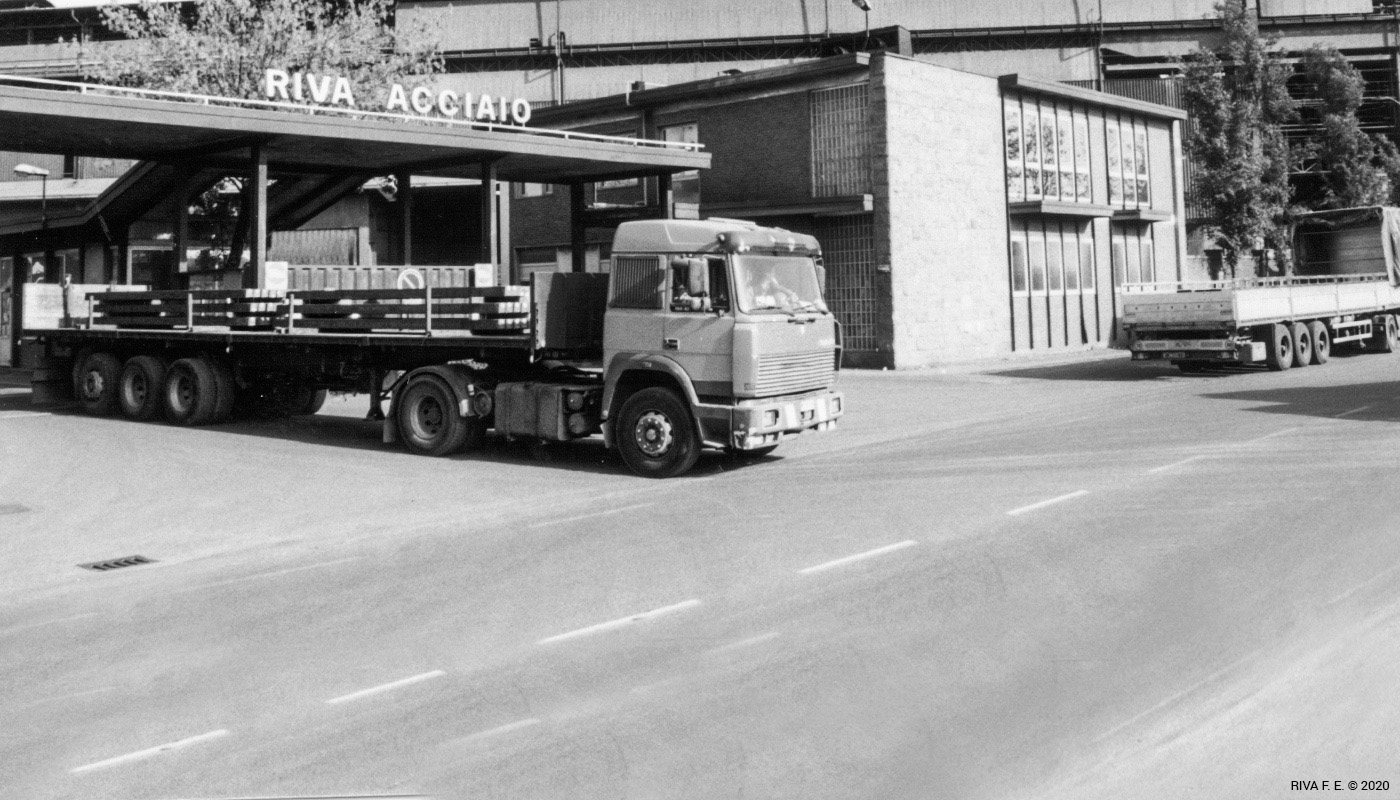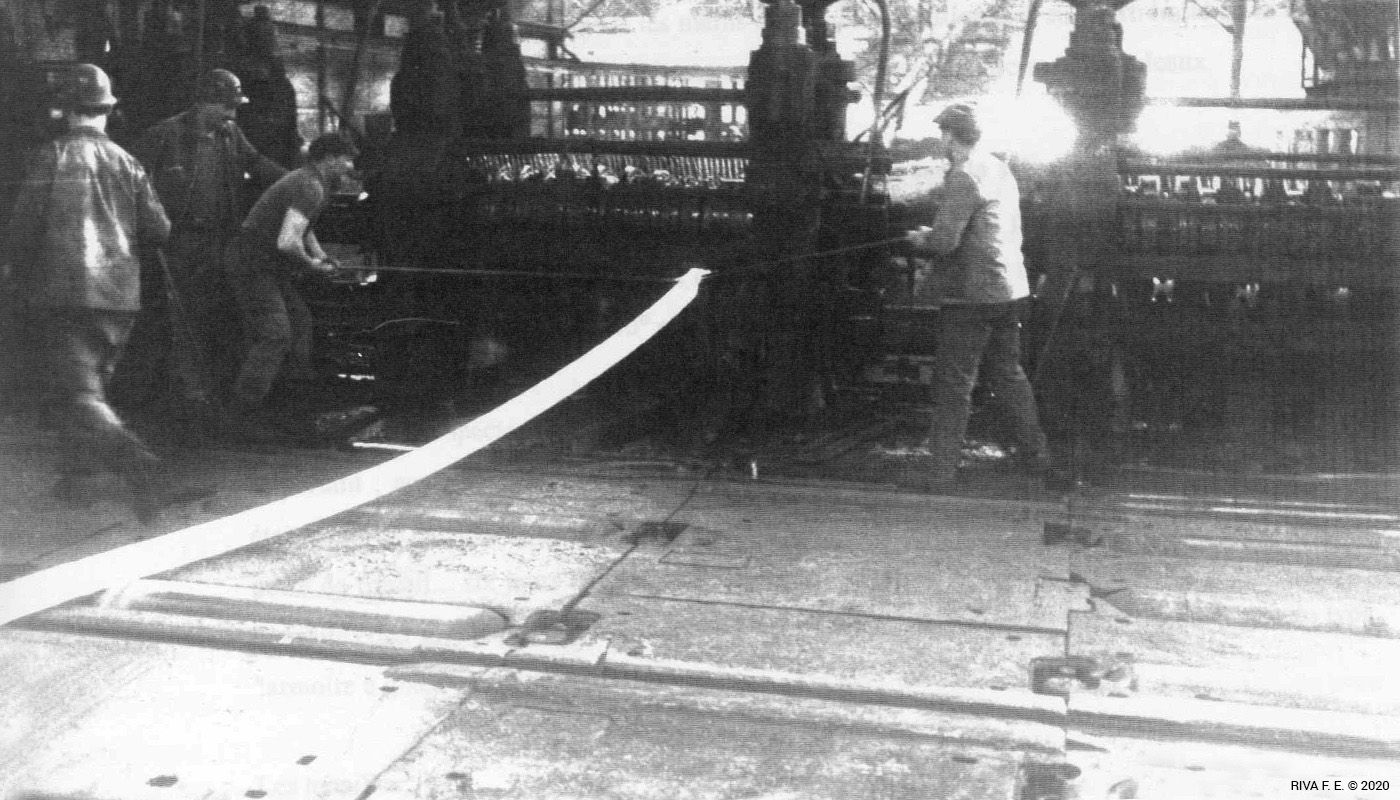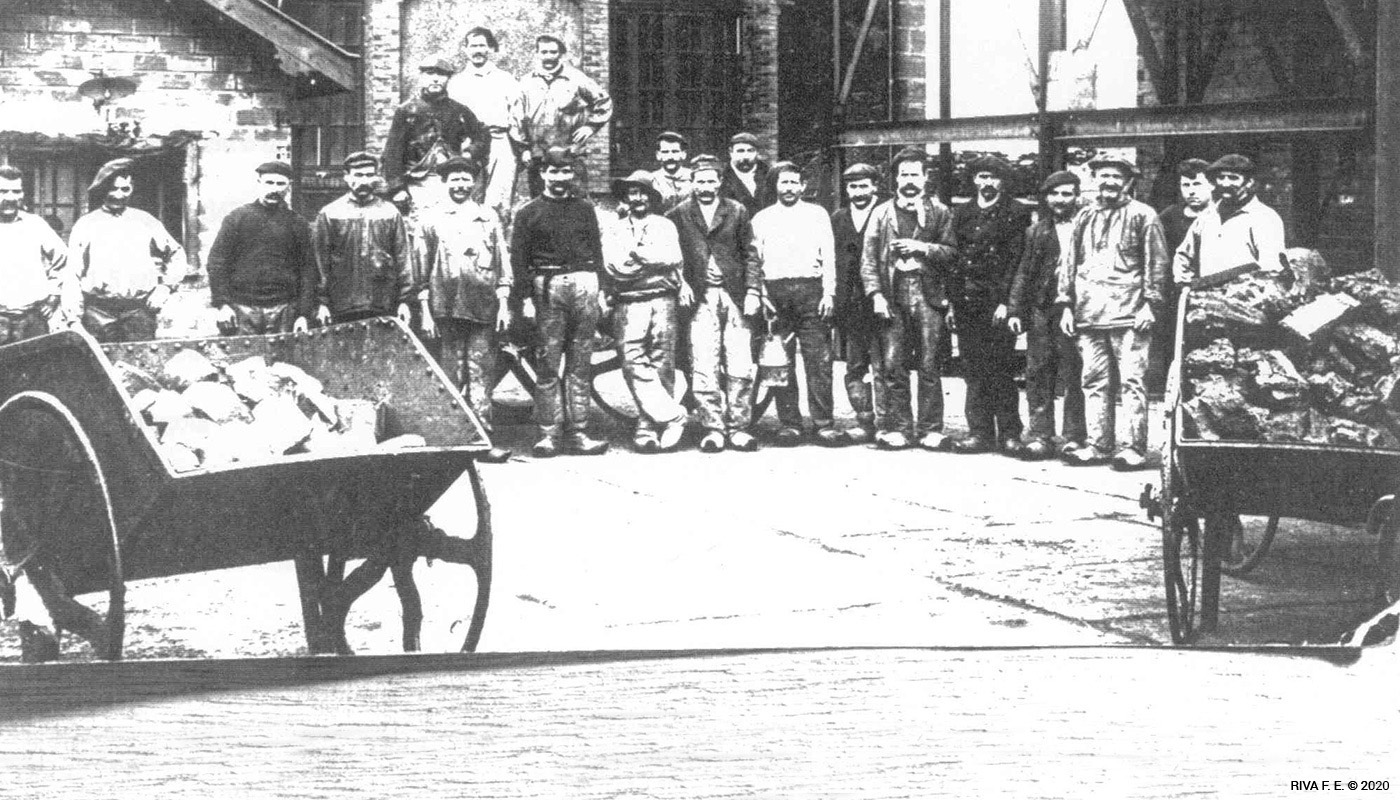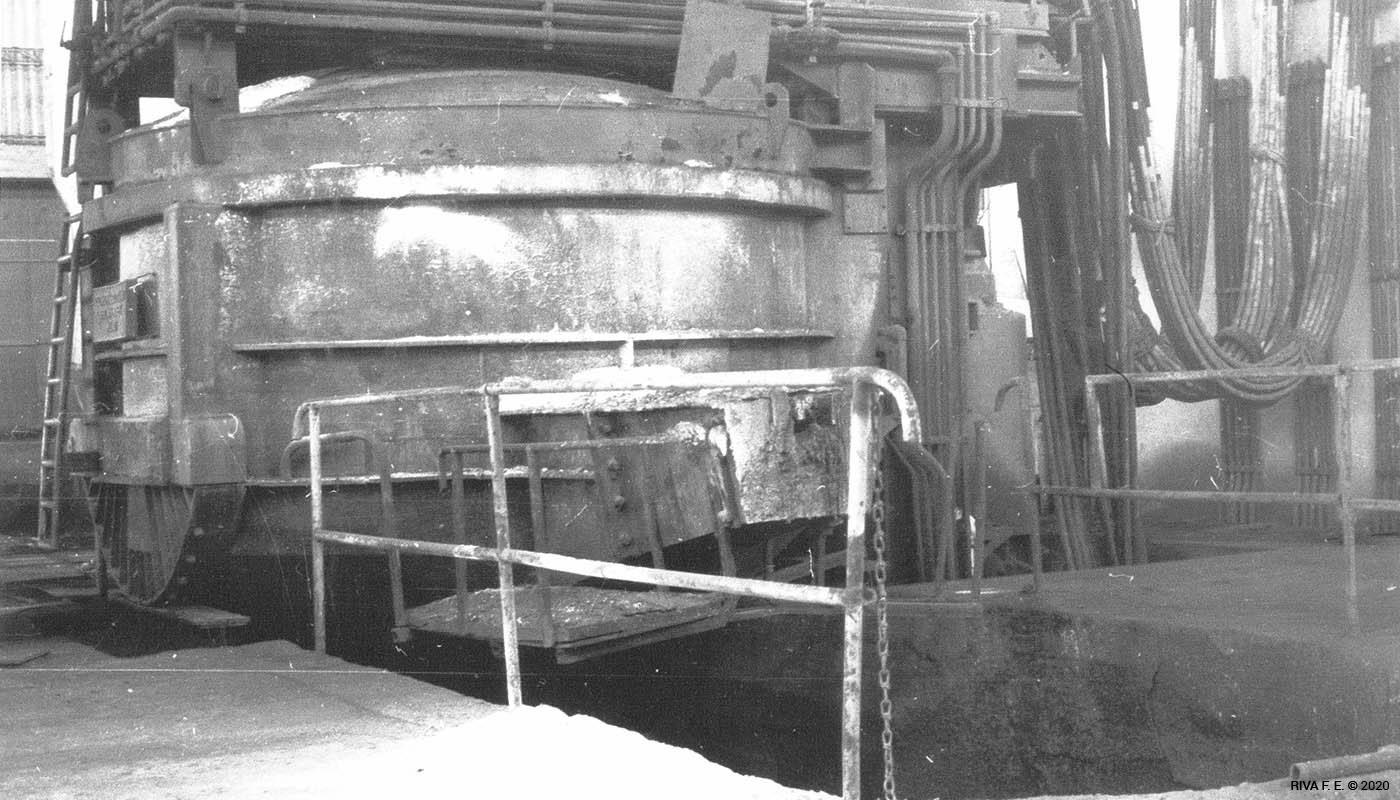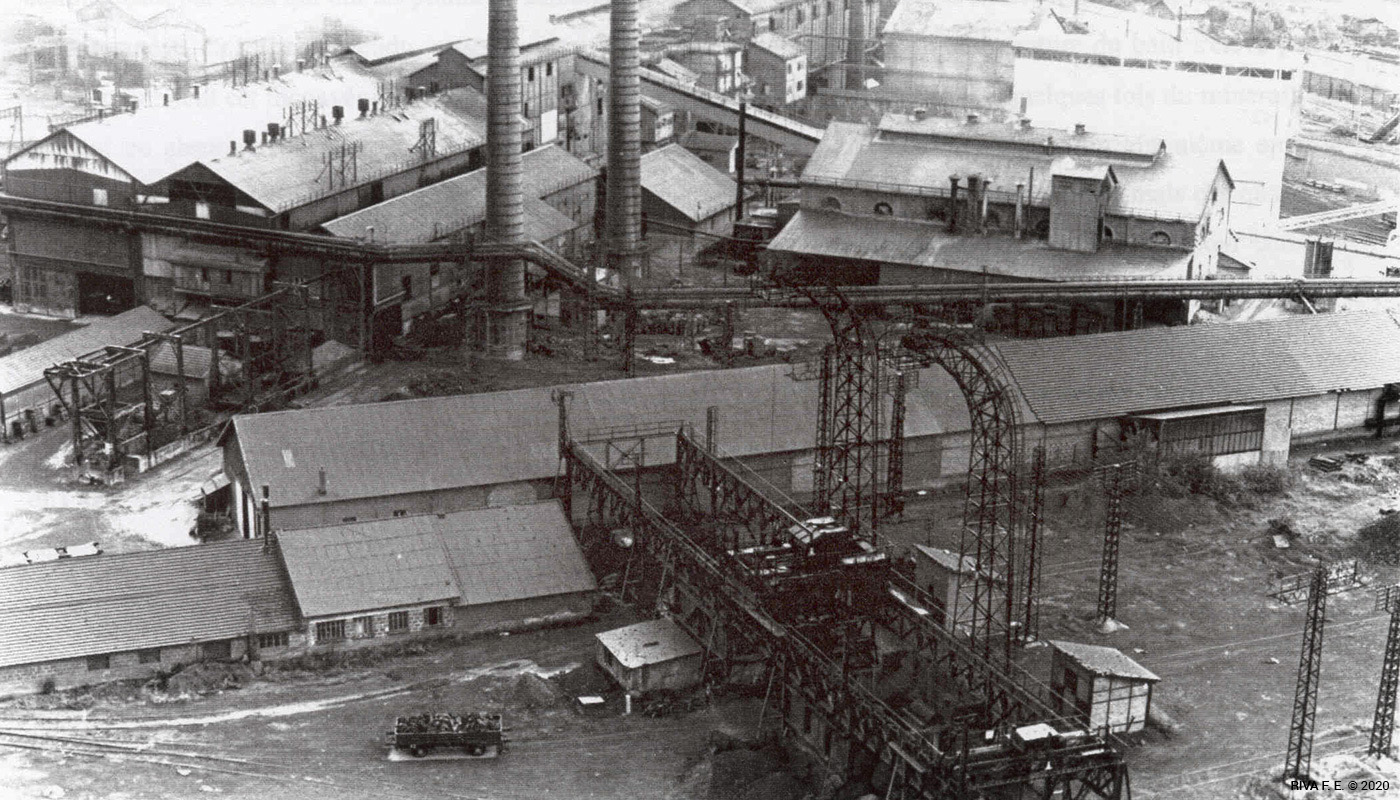1. The first continuous three-line casting in Italy
The mid-1960s were a crucial turning point for Italian steel industry, since many companies found themselves facing more and more open international competition - and not a few of them were forced to close down - fostered by the spread of “mini-steel mills”, which were highly competitive thanks to the electric arc furnace technology.
To keep up with the big foreign manufacturers, it therefore became necessary to make heavy investments in innovation and research. And Riva Group took up this challenge, becoming the first player in Italy to introduce the important technological novelty represented by the curved continuous three-line casting. At the time, in Italy, only Acciaierie di Terni had continuous casting: but it was a vertical one, with one line only and a rather low output.
Emilio Riva was convinced, on the contrary, that the winning solution consisted in the curved model, being studied at the time in Austria, which presented considerable advantages in terms of cost and performance over the vertical kind. He therefore called on Luigi Danieli, owner of the plant engineering company Danieli, and on Renzo Colombo, a famous industrial engineer, to independently develop the new technology in Italy.
The partnership among the industrialist, the designer and the plant engineering company, met with full success, and on June 2, 1964 the first continuous casting by Danieli came into operation in the Caronno plant, also being the first curved three-line continuous casting to be installed in Italy. This was a significant result for the Italian steel industry and especially for the Riva Group, since from then on the company stopped making small ingots - to be then cold-rolled into semi-products (billets) and long products -, and billets began to be made directly from liquid steel, thus improving the performance of the production cycle and cutting down costs considerably.
2. First acquisitions on the Italian market
Working with one plant only however made it difficult to handle an increasingly aggressive competition - not only Italian. Therefore, Riva group decided to start an external growth process and in the late 1960s, it began an acquisition campaign, in Italy and abroad, the most significant step of which was the purchase, in 1995, of Ilva from the Italian government.
The first two acquisitions however date back to 1966 - just two years after the three-line continuous casting began to operate -, when Acciaierie e Ferriere del Tanaro at Lesegno, in the Cuneo province, was purchased, and Riva Group became minority shareholder of SEII-Società Esercizi Impianti Industriali in Malegno (Brescia), at the same time taking over its management. Results came quickly: at the end of the 1960s, the Group was producing 300,000 tons of steel per year and could offer to customers a wide range of long rolled products, thus opening up the promising road to international markets.
3. Starting the international expansion
The 1970s - marked by the first great world oil crisis and a significant standstill in European steel industry which was beginning to feel pressure from low cost exports from such countries as South Korea, Mexico, Argentina and Brazil - saw the Riva Group move once more against the trend, making its first important international investments, first starting with a minority share (1971), and then full control (1978) of Siderúrgica Sevillana in Spain.
In 1974, Riva crossed the ocean establishing Associated Steel Industries (ASI) in Montreal, Canada, a company founded to sort and recover scrap from the imposing pool of North American car market. In 1976, the Group entered the French market, by taking on first a minority share, then management and finally full control (1997) of the Iton Seine steelworks, specialised in top quality rods for reinforced concrete, which quickly obtained the French quality mark CRELOI.
Looking towards Asia, another important record was achieved: in 1978, Riva Group was the first European operator to sell steel directly to China, a market hitherto supplied exclusively by Japan.
At end of the 1970s, while many steel manufacturers were using incentives provided by the European Community and national governments to dismantle obsolete plants, and some were unfortunately being forced to close down, Riva Group invested significant amounts in new technologies, increasing levels of automation in the casting process, multiplying computerised plants, accelerating the development of scientific research and exploring new means of scrap procurement.
4. The 1980s
Thanks to considerable investments and to the many acquisitions carried out during the previous 15 years, in 1980 the steel production of Riva Group reached the noteworthy amount of 1.1 million tons - more than three times the level of the late 1960s - placing the Italian company among Europe's leading operators. Geographically, production was spread out as follows: 61% in Italy, 28% in Spain and 11% in France
Rolled production was nearly 700,000 tons and by now mostly focused abroad, with 45% made in Spain, 21% in France and 34% in Italy. But expansion did not stop here. In fact, in 1981 another important acquisition took place: Officine e Fonderie Galtarossa (OFG) of Verona joined the group, a company specialised not only in high quality reinforced concrete rods, but also in wire rod. Under the new steering, the company increased its production considerably, progressing from 180,000 tons in 1980 to 740,000 tons in 2000.
5. The European steel crisis and the privatisation of Italsider
Looking for a solution to the serious gap between supply and demand for steel products, which had opened a dramatic crisis in the European steel industry, in the early 1980s the European Community launched the so-called “Davignon Plan”, an important and successful project for reorganising the steel sector, aimed at reducing the production capacity of companies in difficulty or receiving government aid, and sometimes at closing them, in order to bring the remaining plants back to competitiveness and thus revamping steel production throughout Europe.
The Italian public steel industry, which like those in other countries was receiving considerable state aid, was asked in 1984 to stop the production of the hot rolling mill in the Italsider plant of Genoa Cornigliano. The remaining part of the manufacturing at the Genoa plant was spin-offed and transferred, one year later, to Consorzio Genovese Acciaio (COGEA), which capital included private shareholders such as Riva Group, although the consortium was still publicly managed. Facing the difficulties in reconciling the needs of the different private shareholders with what was still public management, in 1988 Riva Group decided to purchase the stocks of the other private shareholders and thus obtain the absolute majority, leaving a minority share in public hands and taking over the industrial management of the plant.
This operation was the first privatisation in Italy of an integrated steelworks. Under the new management, the Genoa plant achieved a production of more than 1 million tons per year, allowing Riva Group to expand its product range to slabs, which represent the semi-finished products to obtain flat rolled products.
6. International growth and privatisations abroad
In 1988, Riva Group was involved in another important privatisation, this time in France, a country where it had been operating for more than 10 years, and where it took over a majority share of the ALPA (Aciéries et Laminoirs de Paris) capital, a company which owned a production plant (electric steelworks and rolling plant for reinforced concrete rods) at Gargenville.
In 1989, after another decade of expansion, the steel production had tripled compared to 1980 and reached 3.2 million tons (of which 2.1 million in Italy and 1,1 million in Spain and France); at the same time, the rolled steel production had risen by three times, to 2.2 million tons, covering about 10% of the reinforced bar production in the European area.
But that is not all. Between 1989 and 1992, in fact, expansion abroad moved another significant step forward, focusing on two countries with a long steel making tradition: Belgium and Germany. In Belgium, rolling mill no. 3 at Charleroi-Marcinelle was purchased, with a production capacity of 750,000 tons a year; to feed it, a new electric steel plant was built from scratch. This was the beginning of Thy-Marcinelle, which besides stabilising employment in the area, contributed to bringing back life into a region where Italian labour had a long tradition; a region which, today, is receiving from Italy also qualified entrepreneurial skills, cutting edge technology and considerable financial investments.
In Germany, the process of privatisation of the steel industry following German reunification offered the Group the opportunity of acquiring two big plants located in the region of Berlin: Brandenburger Elektrostahlwerke and Henningsdorfer Elektrostahlwerke. Both plants were taken over in 1992 from Treuhandanstalt, the German governmental agency tasked with privatising the companies of former East Germany: in 1992 these plants produced 749,000 and 360,000 tons of steel respectively, by 2000 production had risen to 1.3 million and 811,000 tons.
7. Acquisition of Ilva Laminati Piani from IRI
In 1994, with an output of 5.8 million tons of steel and 5 million tons of rolled products - double the amount of five years before - Riva Group had finally reached a size positioning it as a leading player among European manufacturers. However it decided to make a further leap forward, which would turn the Group into Europe's second steel manufacturer and player no. 5 at a world level.
In April 1995, as absolute majority shareholder, Riva Group took over from IRI the entire capital of Ilva Laminati Piani. This operation was the most important privatisation in the context of the Italian government’s disengagement plan from the steel manufacturing sector. By purchasing Ilva Laminati Piani, the Group also acquired control over companies producing tinplate (ICMI), sheet iron and large diameter pipes (ILT), and firms transforming flat-rolled products, including Tunisacier, with a plant at Biserta (Tunisia).
Ilva's acquisition played a fundamental role in the history of Riva Group: in terms of production, between 1994 and 1995, yearly output leapt forward from 6 to 14.6 million tons of steel and from 5 to 12.8 million tons of rolled steel. Also, heavy investments by Riva Group in Ilva (over 6 billion euros between 1995 and 2012) turned the Taranto plant in a short time into the largest, most modern and efficient steelworks in Europe.
8. Latest acquisitions
Constant growth went on over the following years. In 1996, the plant at Sellero (Brescia) was purchased from IBL, and in 1997, Ilva took over a majority stake of Hellenic Steel in Greece, a company producing cold-rolled steel, zinc plated steel and tinplate, and in Italy it took over Acciaierie di Cornigliano (formerly Italsider) which had been privatised some 10 years before. Finally, the year 2000 saw the acquisition of the French group SAM (8 manufacturing and transformation plants, 1,500 employees), which produces 1.5 million tons of steel, 70% of which is transformed into wire rod, electro-welded netting and products for the building industry.
Implementing a strategy aimed at improving logistics structures connected to the steel industry, in 1999 the Group also decided to strengthen its shipping sector by purchasing a 250,000 tons transoceanic ship to transport raw materials, a task which had hitherto been performed by third party ships. The Group also reinforced its fleet with two pushers and four 30,000 tons barges for moving finished products, and finally, in 2012, a new 300,000 tons transoceanic ship.
9. Most recent years
A new and innovative Programme Agreement was signed in Genoa in 2005 with the national government, local governments and trade unions, for closing down the blast furnace and the hot production area of the Ilva plant in Cornigliano and simultaneously strengthening the cold production in the same plant. This amounts to full reconversion of the whole manufacturing plant, with decommissioning of blast furnace activity. This made it possible to preserve nearly full employment level (about 2,000 people), while the private ownership assigned to local and public institutions some 343,000 square metres to develop important public services, such as fast lanes, urban upgrading projects, logistical port and airport functions.
This agreement represents a significant example of a profitable and private industrial company accepting to change its production set-up, bearing heavy costs, with environmental requalification in mind, showing how it is possible to find a virtuous balance between industrial needs, environmental restrictions and safeguarding employment.
In July 2012, the seizure of the Ilva plant in Taranto on orders by the local public prosecutor marked the beginning of a series of legal proceedings which are still going on and refer to alleged non-compliance with environmental regulations by the company. In June 2013, this led to Ilva being placed under receivership, followed by what many called an “expropriation without indemnity” of the company, to the damage of the legitimate shareholders. It should be pointed out that the company has rejected the allegations against it, and has always declared to have complied with the many national and international environmental regulations which refer to it.
In the meantime, in order to set up separate company structures for business in flat products coming from the integrated cycle and long products coming from electric furnaces, the company Riva Forni Elettrici was established through a split-off from Riva Fire, the Group holding, and began handling electric furnace production.
The chairman and founder of the Group, Mr. Emilio Riva, died in April 2014, after a long illness.
In June 2014, Claudio Riva, who had played no further operating role in the Group after negotiating the Programme Agreement for Cornigliano, and had gone into business on his own, went back to working in the steel sector and was appointed Chairman of Riva Forni Elettrici, the main Italian steel manufacturer.
In January 2023, the Riva Group acquired 4 collection sites and 4 sorting and shredding sites for scrap metal. The new plants have been grouped under the company TRENTETROIS and allow the group to aim for autonomy in the steel recycling chain, reaffirming one of its core values: sustainability.



